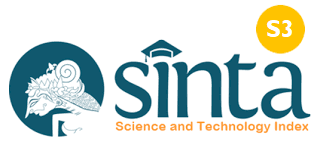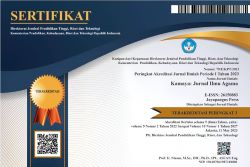Kesetaraan Gender: Perempuan Dalam Perspektif Ajaran Gereja Katolik Menurut Gaudium Et Spes
DOI:
https://doi.org/10.37329/kamaya.v6i2.2454Keywords:
Gender equality, Woman, Catholic church, Gaudium et SpesAbstract
The Catholic Church has always provided space to fight for justice and gender equality to fulfill God's mission in the world. Women's lives have changed dramatically over the past quarter century. Progress on gender equality remains limited. The still strong patriarchal culture prolongs the suffering of the helpless and complicates the struggle and change toward justice and gender equality. Discrimination against women is a common problem in almost all occupations, even in most parts of the world. It can be understood that gender is a distinction that is neither biological nor divine nature. The purpose of this study is to raise the theme of gender equality which is discussed based on Church documents, namely Gaudium Et Spes art. 9 and art. 29. This research uses a type of library research, which has the aim of tracing and analyzing data or information about the essence of Gaudium Et Spes Article 9 and Article 29 documents concerning Gender Equality. The contribution of Gaudium Et Spes Art. 9 and Art. 29 is that the similarities between men and women are through the institution of goodwill in the sense that both men and women participate in what the church stands for, which is the struggle to shape human life more humanely. The Catholic Church also stressed that this will take a long time, considering that the fight for gender equality is not easy, especially in a world that is heavily influenced by patriarchy. In addition, this research is useful to open horizons regarding gender equality and everyone, both men and women, realize the differences that exist as God's goodwill. Through this document, the Church strives to think about how gender issues are taken seriously to avoid injustices in public life.
References
Amar, S. (2017). Perjuangan gender dalam kajian sejarah wanita Indonesia pada abad XIX. Fajar Historia: Jurnal Ilmu Sejarah Dan Pendidikan, 1(1),106-119.
Annisa, R., Idris, M. M., & Sholeh, K. (2021). Analisis Konsep Gender Dalam Undang-Undang Simbur Cahaya Sebagai Sumber Pembelajaran Sejarah. Klaten: Penerbit Lakeisha.
Djazifah, N. (2001). Tindak Kekerasan pada Wanita Pedagang Menginap di Pasar Kota Yogyakarta. Jurnal Penelitian Humaniora, 1(6) 47-67.
Dokumen Gerejawi. (2017). Seri Dokumen Gerejawi No. 19: Gaudium et Spes | Departemen Dokumentasi dan Penerangan KWI. Jakarta: KWI.
Efendy, R. (2014). Kesetaraan Gender Dalam Pendidikan. AL-MAIYYAH: Media Transformasi Gender dalam Paradigma Sosial Keagamaan, 7(2), 142–165.
Fauziah, R., Mulyana, N., & Raharjo, S. T. (2015). Pengetahuan Masyarakat Desa Tentang Kesetaraan Gender. Prosiding Penelitian Dan Pengabdian Kepada Masyarakat, 2(2),259-268.
Fuady, M. I. N. (2021). Perempuan: Perempuan dan Media. In: Keadilan Restoratif pada Kekerasan Seksual di Media Massa. Banda Aceh: Syiah Kuala University Press.
Ima, D., Restu, N., & Yusuf, S. (2020). Nilai-nilai Pendidikan Karakter RA Kartini dalam Buku Habis Gelap Terbitlah Terang. At-Thullab Jurnal Mahasiswa Studi Islam, 2 (1), 350–361.
Ismiati, I. (2018). Pengaruh Stereotype Gender Terhadap Konsep Diri Perempuan. Takammul: Jurnal Studi Gender Dan Islam Serta Perlindungan Anak, 7(1), 33–45.
Kania, D. (2015). Hak asasi perempuan dalam Peraturan Perundang-Undangan di Indonesia: The Rights Of Women In Indonesian Laws And Regulations. Jurnal Konstitusi, 12(4), 716-734.
Mali, M. D. (2019). Peran Hati Nurani Dalam Membentuk Sikap Otonomi Individu Yang Bermoral, Dalam Terang Gaudium Et Spes Artikel 16 (Universitas Katolik Widya Mandira). Kupang: Universitas Katolik Widya Mandira.
Mazaya, V. (2014). Kesetaraan Gender Dalam Perspektif Sejarah Islam. Sawwa: Jurnal Studi Gender, 9(2),323-344.
Rahayu, N. (2012). Kesetaraan Gender Dalam Aturan Hukum dan Implementasinya di Indonesia (Gender Equality In The Rule of Law in Indonesian And Implementation). SAWWA: Jurnal Studi Gender, 9(1), 15–32.
Rokhmansyah, A. (2016). Pengantar Gender Dan Feminisme: Pemahaman Awal Kritik Sastra Feminisme. Yogyakarta: Penerbit Garudhawaca.
Saumantri, T. (2022). Kesetaraan Gender: Perempuan Perspektif Sufisme Jalaluddin Rumi. Equalita: Jurnal Studi Gender Dan Anak, 4(1), 13–28.
Widyaningrum, A. Y. (2020). Beban Ganda Perempuan dan Pemanfaatan Teknologi di Masa Pandemi Covid-19. Yogyakarta: Pusat Studi Wanita Universitas Pembangunan Nasional Veteran.
Wongkar, E. E. L. T., Achmadi, J. C., & Iswarini, T. (2021). Telaah Kritis Efektivitas Pasal 66 UU Perlindungan dan Pengelolaan Lingkungan Hidup Bagi Perempuan Pembela Hak Asasi Manusia Atas Lingkungan. Jurnal Hukum Lingkungan Indonesia, 8(1), 35–72.
Zega, Y. K. (2021). Perspektif Alkitab Tentang Kesetaraan Gender Dan Implikasinya Bagi Pendidikan Agama Kristen. Didaché: Journal of Christian Education, 2(2),160-174.
Downloads
Published
How to Cite
Issue
Section
License
Copyright (c) 2023 Kamaya: Jurnal Ilmu Agama

This work is licensed under a Creative Commons Attribution-ShareAlike 4.0 International License.
An author who publishes in the Kamaya : Jurnal Ilmu Agama agrees to the following terms:
- Author retains the copyright and grants the journal the right of first publication of the work simultaneously licensed under the Creative Commons Attribution-ShareAlike 4.0 License that allows others to share the work with an acknowledgement of the work's authorship and initial publication in this journal
- Author is able to enter into separate, additional contractual arrangements for the non-exclusive distribution of the journal's published version of the work (e.g., post it to an institutional repository or publish it in a book) with the acknowledgement of its initial publication in this journal.
- Author is permitted and encouraged to post his/her work online (e.g., in institutional repositories or on their website) prior to and during the submission process, as it can lead to productive exchanges, as well as earlier and greater citation of the published work (See The Effect of Open Access).
Read more about the Creative Commons Attribution-ShareAlike 4.0 Licence here: https://creativecommons.org/licenses/by-sa/4.0/.





